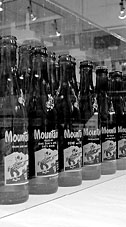|

Comment
on this story
Where:
UT's Ewing Gallery,
1715 Volunteer Boulevard
When:
Through July 9. Call 974-3200 for information.
|
|

The Origins And Evolution of Mountain Dew Memorabilia
by Heather Joyner
Through July 9, UT's Ewing Gallery presents an eclectic exhibit tracing the visual evolution of a product called Mountain Dew, created some 60 years ago. If advertising is indeed the dominant visual form spawned by capitalism, Mountain Dew's various packaging incarnations are artistically as well as socially relevant. Beyond being an ode to humble East Knoxville beginnings, decidedly kitsch Mountain Dew memorabilia in the Ewing show reflects changing approaches to and attitudes about advertising as visual seduction.
I remember anthropologist and UT professor Michael Logan referring to the Gatlinburg/ Pigeon Forge area as being "the cradle of civilization"—terminology as ironic as it is sarcastic, given the economic and cultural significance of that area, and of East Tennessee in general. With true resourcefulness, many folks in these here parts have demonstrated remarkable ambition and sales savvy. Beginning with "See Rock City" barns and granny quilts on clotheslines along the highway, they have created a commercial monster, but their cleverness in promoting a country-fried image that outsiders respond to has resulted in big bucks.
In the mid-1940s, two Illinois-born entrepreneurs named Barney and Ally Hartman had the kind of foothills smarts and pluck described above. They built a beverage plant on Magnolia Avenue in 1932 and ended up bottling a concoction that went well with whiskey. As Barney's daughter put it (according to researcher Dick Bridgforth), "[Dad] just wasn't ashamed to take a drink or two." What the Hartmans acknowledged as their "private whiskey chaser" was named a slang term for moonshine, and "Mountain Dew" eventually became a phenomenon.
In addition to the soft drink's actual ingredients, the brothers' recipe for success included advertising that celebrated a L'il Abner-esque joie de vivre. Post-World War II Americans stepped up their love affair with guns and their quest for good times. The first Mountain Dew label illustration was created in 1946 by John Brichetto, a high school student and neighbor of Barney Hartman at the time. It featured "Willy the Hillbilly" and his shotgun (predecessor to a hillbilly found in Brichetto's "Comical Caricature of the Great Smoky Mountains," also on display at the Ewing). Later labels added a pig, coon dog, outhouse and revenuer. And in decades following its initial promotion, Mountain Dew benefited from a "heapin' helpin'" of TV shows with similar images, such as Davy Crockett, Beverly Hillbillies, Green Acres, and Dukes of Hazard.
Using television to promote the increasingly popular beverage made perfect sense. A mid-'50s hunting and fishing program on Johnson City's old WJHL-TV—called Outdoors with Professor Kingfish—featured a dazed-looking host in overalls with a bottle of Mountain Dew in hand and his shotgun propped against one shoulder (the show also featured someone from Bull's Gap named Archie "Grandpappy" Campbell).
An article titled "Hillbilly Moonshine Makes Sales Magic" (from The American Bottler magazine) credited early Mountain Dew distributors with marketing genius, saying, "[They knew how to combine] the provincialism of [their] trading area with the modernity of 1955 merchandising." By then, Johnson City native Charles Gordon had hooked up with Ally Hartman to become Mountain Dew's first commercial franchise bottler. Two years later and almost a decade after his brother's death in 1949, Ally Hartman sold rights to the soft drink's name to Gordon for $5,000. Gordon, in turn, sold it to (Marion) Virginia's Tip Corporation, a company that called Marion "the home of Mountain Dew" after its affiliation with Tri-City Beverage. PepsiCo bought the soft drink from Tip Corporation. In 1965, PepsiCo acquired Mountain Dew from Tip for an estimated three million dollars.
Adding to Mountain Dew's homespun image were ad slogans like "It'll Tickle Yore Innards!" and "signature" labels indicating that a particular batch was "by Charlie and [associate] Jim" or "by Dean and Dick" (of the North Carolina Minges clan), and so forth. When the formula's 7-Up taste incorporated the flavor of Tri-City lemonade developed by plant manager Bill Bridgforth in 1960, it became the "New Mountain Dew." Felt hillbilly hats were worn by salesmen and handed out to people buying a full case. However ridiculous such promotional efforts might seem now, launched a soft drink that's presently bottled in approximately 40 countries worldwide.
In 1973, PepsiCo shifted its visual emphasis away from the hillbilly character but kept the word "Ya-hooo." To appeal to the youth market of the late '70s, it dropped all hillbilly references.
Alongside signs, bottles, lighters, watches, dolls, pins, and other objects (including a Daisy "Sonic Mystery Gun" with a Mountain Dew Mountaineer sticker), the Ewing show presents TV commercials sans firearms—flashing Mountain Dew's futuristically hip 'n' hyper image of today. As a late baby-boomer, I am exhausted by the Xtreme sports bent of current "Cool Mountain Era" fare, and I find the vulgar and cartoony style of the Mountain Dew hillbilly less appealing than that of late 19th and early 20th Century "characters" like the Michelin man and RCA's dog Nipper. But I appreciate the visual impact of Mountain Dew memorabilia. In High and Low, a book about modern art and pop culture by Kirk Varnedoe and Adam Gopnik, the authors write, "Advertising often pretends to traffic in 'timeless values,' 'ageless beauty,' and 'enduring quality,' but the culture that it spends a great deal of its time selling us—the culture of cars, clothes, music, and other items of fashion—is insistently time-bound and geared to planned obsolescence, continual novelty, and instant nostalgia."
It seems creators of Mountain Dew advertising have always pushed their product in a fairly straightforward manner, and through that directness a very specific design sensibility emerges. Some people consider it art.
Whatever we call it, it's part of our cultural history and worthy of our attention.

June 27, 2002 * Vol. 12, No. 26
© 2002 Metro Pulse
|